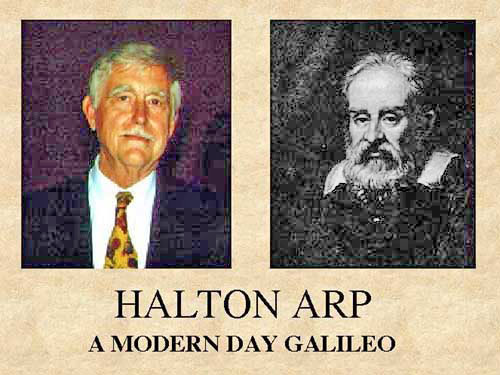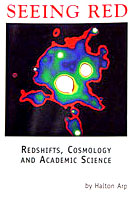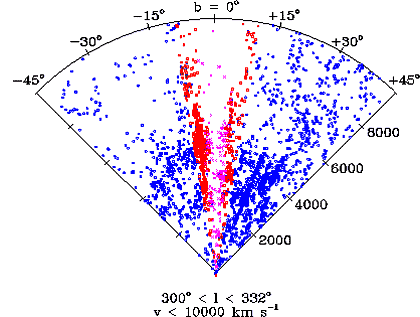|

from
DragonScience Website
|
This is
the introduction to Amy Acheson’s presentation
for the interdisciplinary conference:
INTERSECT: 2001
July 6-9, 2001 Laughlin, Nevada |
Halton Arp is to
the 21st century what Galileo was to the 17th.
Both were respected scientists, popular leaders in their field. Both
made observations which contradicted the accepted theories.
Seventeenth century academics felt threatened by Galileo’s
observations and so, backed by ecclesiastical authority, they
ordered him to stop looking. Twentieth century astronomers felt
threatened by Arp’s observations and so, backed by
institutional authority, they ordered him to stop looking.
Both refused. Both published works geared to the
non-specialist when specialists would no longer take note.
Galileo’s paper, "A Dialogue on the Two Chief Systems of the
World", favored a heliocentric model of the solar system and
undermined the accepted geocentric model. Arp’s books, "Quasars,
Redshifts and Controversies" and "Seeing Red" favor a
steady-state model of the universe and undermine the accepted big
bang model.
The Church responded by
placing Galileo under house arrest: his peers would not even
look through his telescope and journals refused to publish his
results. The modern astronomical community responded similarly to
Arp. Observatory officials cancelled his telescope time and
astronomical journals refused to publish his research.
How did these
men create such a furor?
|
click image

Halton Arp’s
book,
Seeing Red:
Redshifts, Cosmology and Academic Science |
Galileo
introduced a simple new concept that changed the universe as it was
known then. Arp introduces a simple new concept that will
change the universe as we know it now.
Seventeenth Century
educators taught that the Earth was the center of the
universe. The Sun, the moon, the planets and the stars
revolved around it. Galileo confronted his contemporaries
with a universe centered around the sun. If you had lived in
Galileo’s time, would you have been willing to examine his work?
Today’s educators teach that the universe started from a big bang
15 billion years ago and has been expanding ever since. Galaxies
and quasars are scattered according to their redshift. Arp
confronts us with a universe of ejected galactic families.
You live in Arp’s time: are you willing to examine his
work?
STATE OF THE
UNIVERSE 2002
THE BIG BANG is dead.
It’s a theory based on a theory based on an assumption made
nearly 75 years ago, that THE ONLY CAUSE OF REDSHIFT IS
RECESSIONAL VELOCITY. And that assumption was wrong.
Observations in 1911 of intrinsic redshift in young stars crippled
the recessional redshift of galaxies before it was imagined.
Halton Arp’s identification of physical connections between
high-redshift quasars and low-redshift active galaxies
in the late 60’s dealt the mortal blow. The discovery of
quantization of redshifts signed the death
certificate.
Still the Big Bang rises, vampire-like, to haunt the
night, sapping the vitality and the integrity of astronomy.
Photos are cropped between active galaxies and their ejected quasars.
Dark matter spawns dark energy.
Unquestioned superstitions and ritual mathematics adorn a conceptual
graveyard into which are interred billions of dollars of
public funds.
An intrinsic interpretation of the redshift will imply a much
different universe. For example, in the middle of the
constellation of Virgo, the brightest galaxies, the
brightest quasars and brightest clusters of galaxies are
connected by the strongest radio and x-ray fields in the sky.
The expanding universe assumption - that redshift equals
velocity equals distance - separates these objects by billions
of light-years, and assumes their side-by-side position is
coincidental. But it’s not coincidence. These objects
belong together. They make up an evolving galactic family
whose genealogy can be traced through four generations.
We’ll never "see" this universe as long as we remain captive
in the coffin of the Big Bang viewpoint. The assumption that
redshift can only be caused by recessional
velocity predetermines a distorted understanding of the shape,
age, size, and physical characteristics of most of the extragalactic
universe. A different - intrinsic - interpretation of the redshift
will imply a much different universe. Even the meaning of the terms
we use to describe that universe will have to change.
Take, for example, the
term, "galactic cluster." That term is currently defined by
the yardstick of Big Bang expansion: at least 30 galaxies (in
addition to the brightest two) within a range of 2 magnitudes and
approximately the same redshift. According to this
definition, there are 4,073 clusters (listed in the revised northern
and southern Abell Catalogue.)
Now let’s look at a galactic cluster in the non-Big
Bang universe. Let’s assume (as Halton Arp’s observations
seem to suggest) that a galactic cluster is a family of galaxies and
quasars and gaseous clouds of varying redshifts. At the
center, we find a dominant galaxy - it’s usually the largest
galaxy, and the galaxy with the lowest redshift of the
cluster. This dominant galaxy is surrounded by
low-to-medium redshift galaxies, and toward the edges of
the cluster we find the highest redshift galaxies,
HII regions, BL Lac objects and quasars.

If we try to force
this configuration into a redshift-equals-velocity-equals-distance
relationship, as Big Bang cosmologists do, the cluster
will be distorted. What was once a sphere becomes an elongated
bubble. The central dominant galaxy drops to the front of the
bubble, followed by a spike of low-to-medium redshift galaxies
stretching away from the earth (see illustrations: "Seeing Red..",
pp. 69 and 71). Every cluster in the sky does this, like starfish
arms pointed away from the earth in every direction. Because we used
redshift distance as the criteria for determining which
galaxies belong in the cluster, we then draw an arbitrary line
where the redshift gets higher than a predetermined level and,
voila, everything beyond that line becomes BO: background
objects. The Big Bang vampire has amputated the
majority of galaxies from our original cluster.
Now compare this to an actual plot of Virgo Cluster members
set at their assumed velocity-redshift distance. You can see the
spike (in fact, there are two of them, associated with two
generations of the galactic family), long, narrow fingers pointing
directly at the earth.

You can see the front
end of the bubble spreading out. What you don’t see in this Virgo
Cluster plot, because of the arbitrary assumption
that higher redshift objects are too far away to belong to the
cluster, are the sides and the back of the bubble, where young
groups of galaxies are artificially clumped into background clusters
on the basis of their redshifts. The highest-redshift objects,
the quasars, are also stretched out of this picture.
Yet, when observed through our earth-based telescopes, they are "coincidentally"
embedded in nearby hydrogen clouds, at the exact centers of x-ray
fields and lined up in pairs across the spin axes of active
foreground galaxies.

Copernicus knew
the Earth wasn’t the center of anything. But
this diagram, based on Big Bang assumptions, says the
Earth is the center of the universe! The AAO
newsletter of August 1996 shows this diagram for all galaxies, not
only the Virgo cluster. They remark on the "Finger of God"
nature of the plot. But the obvious question - doesn’t this mean
that the Earth is the center of the Universe? - eludes
them.
The Big Bang universe will be restructured by intrinsic
redshift into an entirely different form. Instead of a
finite 12 billion light-year radius sphere centered on the earth,
the limits of the intrinsic redshift universe are
undefined, possibly infinite. But the extent
of what we have observed is smaller, probably organized into two
superclusters a few hundred megaparsecs across. Beyond that lie
unknown amounts of extragalactica incognito.
In this new paradigm, the collapsing concepts of the Big
Bang fall into entirely different places. Here’s a sample
glossary from the Intrinsic Redshift Universe:
-
When speaking of
extragalactic objects, the term “high redshift” means
“young”. It does not imply “far away”, “high
velocity” or “expanding universe.”
-
Background
objects probably aren’t.
-
Our local
cluster of galaxies has more members than presently
believed. Before Arp, only objects with redshifts
below 300 km/sec were admitted to the local cluster. From
Arp’s observations, higher- redshift dwarf galaxies and
galaxies interacting with local-group nebulosity are also
part of the local group. Even quasar-like 3C 120, with its
superluminal (faster-than-light) ejections, becomes a local
group member. Corollary of 3) The superluminal expansion of
3C 120 no longer needs an ad hoc explanation. If it is a
member of the local cluster, then it is nearby, not at the
edge of the universe, and its ejections become normal sub-lightspeed
ejections.
-
The oft-invoked
concept “colliding galaxies” (or “merging galaxies”)
is a fake. It’s especially misleading when called
upon to explain a priori assumptions, for example “quasar
activity is induced in host galaxies by galactic
collisions.” In most cases, it is accurate to replace the
randomly occurring “colliding galaxy” with the evolutionary
process “ejecting galaxy.”
-
The concept of
black holes, mass so tightly packed that everything falls
in, is a poor explanation for an active galactic nucleus,
where observations show that everything appears to be
falling out.
-
Cannibalistic
black holes ambushing passing galaxies are Big Bang
fantasies. When we see galaxies tangled together in a
high-energy mass, we’re witnessing the birth of a new
generation of quasars, galactic groups and companion
galaxies.
-
The unobservable
and undetectable “missing mass” that Big Bang
theory claims makes up 99% of the universe isn’t “missing”.
It simply isn’t there.
-
The age of the
universe can no longer be counted by retrocalculating
an expanding universe back to a singularity.
-
Distances,
masses and luminosities of high-redshift quasars,
galaxies and clusters need to be recomputed as a function of
something other than their redshift. Corollaries of 9)
Quasars are not the “brightest objects in the universe” -
their magnitude is brighter than stars, but not as bright as
most galaxies. Gamma Ray Bursters don’t “release
more energy than the Big Bang”. When placed at their
proper close-by distance, their energy output becomes more
reasonable.
-
So-called “gravitational
lensing” of background quasars and galaxies becomes
ejection phenomena. This is especially true in the most
notorious case of gravitational lensing, the “Einstein
cross”: Supposedly, four images of the same quasar wrap
around the nucleus of a low-redshift galaxy. However, a
bridge of high redshift hydrogen connects two of the “quasar
images” and crosses in front of a lobe of the low-redshift
galaxy. This proves conclusively that these images are
not the same quasar, nor are they background objects.
THE STATE OF THE
UNIVERSE -- 2001
The universe as we
understand it is badly in need of repair and
re-evaluation. Observations do not support the
theoretical constructs and mathematical ad hoccery of
expanding universe/Big Bang cosmology. The time has come
to take off our doppler-colored glasses and reexamine the pin-points
of light beyond the Milky Way.
|




